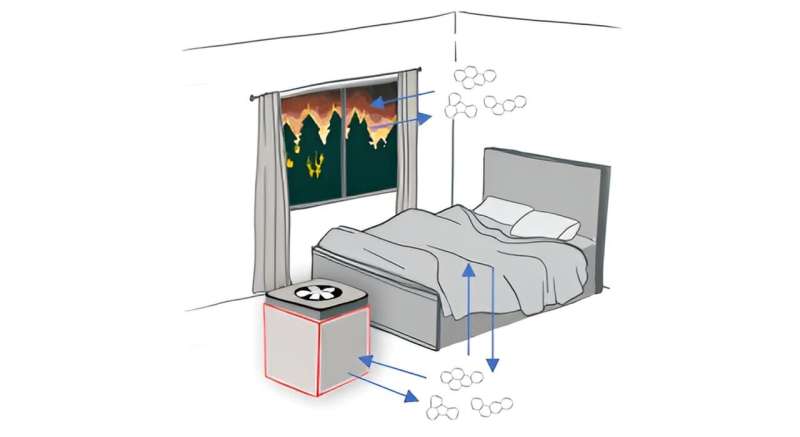
Credit: Environmental Science & Technology (2023). DOI: 10.1021/acs.est.3c05547
After the last embers of a campfire dim, the musky smell of smoke remains. Whiffs of that distinct smokey smell may serve as a pleasant reminder of the evening prior, but in the wake of a wildfire, that smell comes with ongoing health risks.
Wildfire smoke is certainly more pervasive than a small campfire, and the remnants can linger for days, weeks and months inside homes and businesses. Recent research from Portland State’s Elliott Gall, associate professor in Mechanical and Materials Engineering, examined how long harmful chemicals found in wildfire smoke can persist and the most effective ways to remove them with everyday household cleaners.
Wildfires create compounds called polycyclic aromatic hydrocarbons (PAHs), which are formed in the combustion process at high temperatures. These compounds are highly toxic.
“They are associated with a wide variety of long-term adverse health consequences like cancer, potential complications in pregnancy and lung disease,” Gall said. “So if these compounds are depositing or sticking onto surfaces, there are different routes of exposure people should be aware of. By now, most people in Portland are probably thinking about how to clean their air during a wildfire smoke event, but they might not be thinking about other routes of exposure after the air clears.”
Public messaging is fairly consistent on what to do during a fire to reduce exposure to smoke—close windows and doors, run an air purifier and consider wearing a mask—but messaging is limited about what to do post-wildfire. Gall’s study published in Environmental Science & Technology looked at the accumulation and retention of PAHs over a period of four months on three different indoor materials: glass, cotton and air filters.
“We looked at a limited number of materials and we intentionally included some that are common in indoor environments,” Gall said.
Initial findings showed that levels of PAHs remained elevated for weeks after exposure. After materials were loaded with PAHs from wildfire smoke, it took 37 days for PAHs to decrease by 74% for air filters, 81% for cotton and 88% for glass. That reduction is significant but it takes time and means increased health risks from elongated exposure. However, laundering cotton materials just one time after exposure to smoke reduced PAHs on the material by 80%. Using a commercial glass cleaner on glass materials like windows and cups reduced PAHs between 60% and 70%.
Unlike glass and cotton, air filters can’t be cleaned and need to be replaced after an extreme smoke event.
“Even if there’s potentially some more life in them, over time PAHs can partition off the filter and be emitted back into your space,” Gall said. “While it may be a slow process, our study shows partitioning of PAHs from filters and other materials loaded with smoke may result in concentrations of concern in air. And while that partitioning is occurring, dermal contact and ingestion of PAHs from the materials may be important. One example might be holding and drinking from a glass that was exposed to wildfire smoke.”
Gall said it was important to consider the effect of cleaning solutions available to the average person. Although the findings also open the door to additional questions. How do materials like drywall or ceramic respond to cleaning, for example? What if an individual has access to a washer but not a dryer, would PAHs still be reduced to non-toxic levels?
The good news is that although toxic compounds after a wildfire can long outlast the palpable smoke, simple household cleaning techniques are effective in significantly reducing exposure. Gall said future studies on this subject will focus on additional surfaces common indoors and cleaning techniques to reduce PAHs, as well as work to understand the extent of possible health impacts from exposure.
More information:
Aurélie Laguerre et al, Polycyclic Aromatic Hydrocarbons (PAHs) in Wildfire Smoke Accumulate on Indoor Materials and Create Postsmoke Event Exposure Pathways, Environmental Science & Technology (2023). DOI: 10.1021/acs.est.3c05547
Citation:
Targeted household cleaning can reduce toxic chemicals post-wildfire, research shows (2024, January 2)
retrieved 3 January 2024
from https://phys.org/news/2024-01-household-toxic-chemicals-post-wildfire.html
This document is subject to copyright. Apart from any fair dealing for the purpose of private study or research, no
part may be reproduced without the written permission. The content is provided for information purposes only.
>>> Read full article>>>
Copyright for syndicated content belongs to the linked Source : Phys.org – https://phys.org/news/2024-01-household-toxic-chemicals-post-wildfire.html































